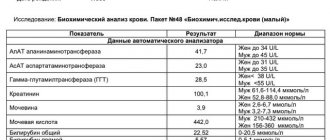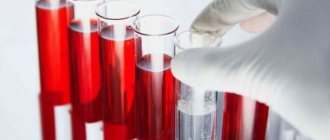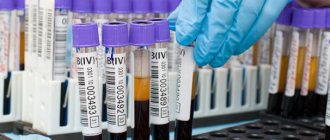When examining healthy people, only total cholesterol is included in the biochemical analysis: if it is normal, then individual lipid fractions also do not exceed normal values. If disturbances in biochemical processes are suspected, an extended lipid profile is prescribed. It includes:
- triglycerides – large molecular lipid fraction;
- very low density lipoproteins (ratio of cholesterol and protein in the bundle - 4:1) - precursors of LDL;
- low-density lipoproteins (cholesterol to protein ratio – 1:1) – “bad” cholesterol with high atherogenicity, is the main cause of atherosclerosis;
- high-density lipoproteins (cholesterol to protein ratio – 1:4) – “good” cholesterol with high antiatherogenicity, cleanses the walls of blood vessels from LDL accumulations.
There are:
- primary lipid profile (prescribed for elevated total cholesterol);
- repeat lipid profile (prescribed 1.5-2 months after the primary one to clarify the cause of the disease, adjust treatment and monitor the patient’s condition).
Why is it important to measure your blood cholesterol levels?
Cholesterol is an indicator whose level is important to monitor not only in old age, but also in youth.
Over the past few decades, the number of patients suffering from atherosclerosis has increased dramatically. The danger of cholesterol is that it can be deposited on the walls of blood vessels in the form of atherosclerotic plaques. When a plaque clogs a vessel, a heart attack, stroke, kidney failure and other illnesses can occur, leading to disability and even death. Important:
Often atherosclerotic plaques form in large vessels in places where they bend. These are the vessels around the heart, as well as those leading to the brain.
Not everyone knows that there are two types of cholesterol. People call them “good” and “bad”. “Good” cholesterol is produced by the human body. It is necessary for normal metabolic processes and makes up approximately 80% of the total cholesterol. “Bad” cholesterol can only be obtained from the outside, that is, through food.
The test cannot divide cholesterol into good and bad; it will show its overall level in a person’s blood. If it is elevated, other examinations should be performed that will show the condition of the patient’s blood vessels, the presence of plaques and other problems. This is why it is important to regularly take blood tests for cholesterol.
You can find out more information about this and many other important aspects of health related to blood pressure, osteochondrosis, atherosclerosis by becoming a member of the Club of Former Hypertensive Patients
.
Join our community, download gymnastics, which has already helped hundreds of thousands of people overcome blood pressure surges and hypertension. Get the most up-to-date and correct information, ask your questions to Dr. Shishonin and just communicate.
Decoding the results
As we have already found out, it cannot be said that cholesterol is an absolute evil and the lower its level in the blood, the better. Moreover, from a medical point of view, cholesterol levels that are too low carry even greater health risks than cholesterol levels that are too high. Indicators should be within normal limits.
What is the normal level of cholesterol in the blood?
The normal cholesterol concentration depends on the age and gender of the person (see table)[8].
| Age | Norm in men, mmol/l | Norm for women, mmol/l |
| Up to 30 days | 1,4–3,9 | 1,6–4,01 |
| 1–5 months | 2,09–3,8 | 1,6–3,65 |
| 6–12 months | 1,9–4,63 | 1,97–5,59 |
| 1–3 years | 2,2–4,71 | 2,79–4,99 |
| 4–6 years | 2,84–5,61 | 2,74–4,99 |
| 7–9 years | 2,8–5,46 | 2,6–5,43 |
| 10–12 years | 2,7–5,77 | 2,72–5,64 |
| 13–15 years old | 2,35–5,28 | 2,79–5,3 |
| 16–17 years old | 2,12–4,97 | 2,38–6,05 |
| ≥ 18 years old | 2–5,18 | 2–5,18 |
| <5.18 – normal level; 5.18–6.19 – moderately elevated; > 6.22 – high level | <5.18 – normal level; 5.18–6.19 – moderately elevated; > 6.22 – high level |
The normal triglyceride content for men and women over 18 years of age is 0.2–1.7 mmol/l. And the normal HDL level for men is > 1.45 mmol/l. The HDL standard for women is > 1.68 mmol/l. The normal level of low-density lipoproteins in men is -
Be that as it may, the content of this total cholesterol above the norm means the need for a more thorough and in-depth analysis of the patient’s lipid profile.
Why is cholesterol high?
Let's say the analysis showed that your cholesterol level is higher than normal. This is typical for diseases such as:
- congenital hyperlipidemia[9];
- pathologies of the hepatobiliary system;
- pancreas cancer;
- diabetes;
- hypothyroidism;
- kidney pathologies.
Sometimes high cholesterol levels are a consequence of an unhealthy lifestyle[10]: in people suffering from alcoholism and obesity, as well as in those who are too fond of fatty foods, this indicator approaches the upper limit of normal and sometimes even crosses it.
And finally, during pregnancy there is also often a slight increase in cholesterol levels.
Why is cholesterol low?
If tests show low cholesterol, this may also be a sign of certain diseases[11]:
- hypolipoproteinemia;
- hyperthyroidism;
- liver cancer and other oncological diseases;
- liver cirrhosis, especially in the later stages;
- chronic anemia;
- bone marrow pathologies;
- chronic pulmonary pathology.
A decrease in cholesterol concentration is also characteristic of acute infections, sepsis and extensive burns. Errors in diet can also reduce this indicator [12]: people who are overly addicted to fasting and very strict diets, as well as those who consume too many fatty acids (omegas), often have low cholesterol levels.
No matter what your blood test shows, you should never try to raise or lower your cholesterol levels on your own, without consulting your doctor. In the vast majority of cases, high or low levels of this compound have very specific reasons - diseases that need to be treated.
How to prepare for complex analyzes
Dr. Shishonin says that such an analysis can be done by anyone without special training. However, this only applies to those cases where only one indicator is to be analyzed, that is, cholesterol.
If the patient is also measuring blood sugar (glucose) levels, there are some limitations to consider. Before this analysis you must:
- don't have breakfast;
- do not drink tea, coffee, carbonated drinks, juices;
- In the morning you can only drink clean water.
These restrictions are necessary in order not to provoke the release of sugar into the blood, otherwise the analysis will be unreliable.
Cholesterol does not have a direct relationship between its level in the blood and food intake. Therefore, you can take such an analysis at any time of the day, immediately after a meal or before a meal - it doesn’t matter.
Biochemical screening: Cholesterol, Glucose
Glucose test
Glucose and metabolites of carbohydrate metabolism play a critical role in providing energy to body tissues and in cellular respiration. A prolonged increase or decrease in its content leads to serious consequences that threaten human health and life. Therefore, doctors attach great importance to monitoring blood glucose levels. Its concentration in the blood is influenced by several hormones at once - insulin, glucagon, somatotropin, thyrotropin, T3 and T4, cortisol and adrenaline, and as many as 4 biochemical processes are involved in the production of glucose - glycogenesis, glycogenolysis, gluconeogenesis and glycolysis. For diagnostic purposes, it is important to know reference values, as well as deviations within and outside normal limits, which depend on the timing of meals and the presence of diabetic symptoms. In addition to glucose, there are other markers of blood sugar: fructosamine, glycated hemoglobin, lactate and others. But first things first.
Glucose in human blood
Like any other carbohydrate, sugar cannot be directly absorbed by the body and requires breakdown into glucose using special enzymes that have the ending “-ase” and are collectively called glycoside hydrolases (glycosidases), or sucrases. “Hydro-” in the name of the enzyme group indicates that the breakdown of sucrose into glucose occurs only in an aqueous environment. Various sucrases are produced in the pancreas and small intestine, where they are absorbed into the blood in the form of glucose.
So, glucose (dextrose) is formed by the breakdown of carbohydrate compounds into simple, or monosaccharides. It is absorbed by the small intestine. Its main (but not only) source is foods rich in carbohydrates. It is extremely important for the human body that the amount of “sugar” is maintained at a constant normal level, as it supplies energy to the cells. It is especially important to provide this substance in a timely manner to the skeletal muscles, heart and brain, which need energy most of all.
If the sugar content is outside the normal range, then:
- energy starvation of cells occurs, as a result of which their functionality is significantly reduced; if a person experiences chronic hypoglycemia (low glucose levels), then damage to the brain and nerve cells may occur;
- excess substances are deposited in tissue proteins, causing their damage (with hyperglycemia, the tissue of the kidneys, eyes, heart, blood vessels and nervous system is destroyed).
The unit of change in glucose is millimoles per liter (mmol/L). Its level depends on a person’s diet, his motor and intellectual activity, the ability of the pancreas to produce insulin, which has a sugar-lowering effect, as well as the intensity of production of hormones that neutralize insulin.
There is another internal source of glucose - it is activated when glycogen reserves are depleted, which usually happens after a day of fasting or earlier - as a result of heavy nervous and physical stress. This process is called gluconeogenesis, which is designed to synthesize glucose from:
lactic acid (lactate), formed in loaded muscles and red blood cells;
glycerol, obtained by the body after fermentation of adipose tissue;
amino acids - they are formed as a result of the breakdown of muscle tissue (proteins).
Blood test for glucose (sugar): normal values
The study of sugar levels is carried out in several ways, for each of which there are corresponding indications. Determining the concentration of this substance makes it possible to diagnose a number of serious diseases.
Fasting blood sugar
This test is taken after an 8-14 hour fast. Blood is drawn from a vein. The general norm of glycemia in adults is 4.1-5.9 mmol/l, in children from one month to 14 years old - 3.3-5.6 mmol/l, in infants up to a month - 2.8-4.4 mmol /l. In elderly people (over 60 years old) and women during pregnancy, the levels may increase slightly and reach 4.6–6.7 mmol/l.
A similar study is carried out:
- during preventive examinations;
- with obesity or the presence of pathologies of the liver, adrenal glands, thyroid gland, pituitary gland;
- if you have symptoms of hyperglycemia: increased urination, constant thirst, blurred vision, fatigue and susceptibility to infections;
- if there are signs of hypoglycemia: increased appetite, sweating, clouding of consciousness, weakness;
- for the purpose of monitoring the patient’s condition: in prediabetic conditions and diabetes;
- to exclude gestational diabetes: women at 24–28 weeks of pregnancy.
Detection of fasting glucose in a volume of 7.0 mmol/l or higher is a serious reason for conducting additional laboratory tests, including hormones and enzymes.
Blood sugar “loaded” with glucose
If the results of a standard sugar test raise doubts among specialists, then a glucose tolerance test is performed. It can also be performed to detect diabetes and various carbohydrate metabolism disorders.
Such a study is indicated in the presence of clinical signs of diabetes, combined with normal blood glucose levels, periodic detection of sugar in the urine, an increase in the daily amount of urine, a hereditary tendency to diabetes, or the presence of retinopathy of unknown origin. This analysis is carried out for women who have given birth to children weighing more than four kilograms, as well as for their children.
During the examination, the patient's blood is taken on an empty stomach, and then he takes 75 grams of glucose dissolved in tea. For children, the dosage is calculated using the formula 1.75 grams/kg. A repeat analysis is carried out 1–2 hours after consuming the drug, and the blood sugar level should not exceed 7.8 mmol/l. If the plasma glucose level 2 hours after administration in the oral glucose tolerance test is 11.1 mmol/l or higher, this is a direct indication of diabetes mellitus. If the glucose concentration is below 11.1 mmol/l, but above 7.8 mmol/l, we are dealing with impaired glucose tolerance.
Glycated hemoglobin
The combination of erythrocyte hemoglobin with glucose. Measuring the concentration of glycated hemoglobin allows you to determine the blood sugar level over the last 2-3 months. To carry out the analysis, biomaterial is taken from the patient after a two- or three-hour fast. The advantages of this analysis include the fact that its results are not affected by the presence of stress or infections in the patient, or by taking medications.
The study is shown:
- for diagnosing prediabetic conditions and diabetes;
- to study the dynamics of the condition of diabetic patients;
- to assess the effectiveness of prescribed treatment;
Glycated hemoglobin is measured as a percentage of the total hemoglobin. A level of less than 6% is considered normal. A value of 6.5% and above is a criterion for diagnosing diabetes mellitus.
Fructosamine
It is a combination of glucose with plasma proteins, which allows you to determine the average sugar content over the last 2-3 weeks. To conduct the analysis, venous blood is taken from the patient after an 8-hour fast. The normal concentration of fructosamine is less than 319 µmol/l.
To retrospectively assess the patient’s condition, the content of glycated hemoglobin is most often determined (the analysis shows the glucose concentration for 3 months), and measurement of fructosamine concentration is prescribed when it is necessary to assess the patient’s condition over the past few weeks, in particular:
- when there is a sudden change in the diabetes treatment plan;
- during pregnancy in women with diabetes;
- in patients with anemia (in their case, testing for glycated hemoglobin does not provide accurate results).
If a value above 370 µmol/l is recorded, this indicates decompensation of carbohydrate metabolism, renal failure, hypothyroidism or an increase in immunoglobulin class A (IgA). If fructosamine is below 286 µmol/l, this is a reason to suspect hypoproteinemia (hypoalbuminemia) in nephrotic syndrome, diabetic nephropathy, hyperthyroidism, or excessive intake of ascorbic acid.
C-peptide
This is a component of pancreatic secretion, which allows you to evaluate insulin production. Measuring the amount of this substance makes it possible to diagnose diabetes and evaluate the effectiveness of its treatment. C-peptide and insulin are produced in equal proportions, but the concentration of C-peptide is constant and does not depend on the level of glucose in a person’s blood. Accordingly, determining its amount allows you to assess insulin production with high accuracy. Normal fasting C-peptide levels vary widely - 260–1730 pmol/l.
An increase is observed after eating, hormonal drugs, glucocorticosteroids, contraceptives and some others. If this factor is excluded, beta cell hypertrophy, insulinoma, the presence of antibodies to insulin, non-insulin-dependent diabetes mellitus, somatotropinoma (pituitary tumor), apudoma (tumor that uncontrollably produces insulin into the blood), and renal failure are possible. A low level of C-peptide indicates insulin-dependent diabetes mellitus, insulin therapy, alcoholic hypoglycemia, stress, and the presence of antibodies to insulin receptors (in insulin-resistant type II diabetes mellitus).
Why might blood glucose levels be high or low?
So, increased blood glucose is observed in the presence of diseases of the endocrine system, pancreas, kidneys and liver, with heart attack and stroke, and diabetes mellitus. Almost the same reasons, only with the opposite sign, lead to a decrease in blood glucose. Sugar is reduced in pathologies of the pancreas, some endocrine diseases, insulin overdose, severe liver diseases, malignant tumors, fermentopathy, autonomic disorders, alcohol and chemical poisoning, taking steroids and amphetamines, fever and severe physical exertion. Hypoglycemia can occur with prolonged fasting, as well as in premature infants and in infants born to mothers with diabetes.
How to return your sugar level to normal limits?
If there are minor deviations from the normal blood glucose level, it is recommended to adjust your diet. Patients with hyperglycemia need to limit the intake of carbohydrates from food. The “prohibited” group includes sugar-containing foods, white bread, pasta, potatoes, wine and carbonated drinks. At the same time, you should increase the consumption of foods that lower sugar levels (cabbage, tomatoes, onions, cucumbers, eggplants, pumpkin, spinach, celery, beans, etc.)
Patients with diabetes are recommended to adhere to diet No. 9. The use of sweeteners, in particular sucrasite, aspartame and saccharin, is allowed. However, such drugs can cause a feeling of hunger, and in some cases, stomach and intestinal upsets. The permissible dosage of these drugs should be determined by a doctor.
If you have hypoglycemia, you should increase your intake of proteins, which are found in large quantities in nuts, beans, dairy products and lean meats. Prevention of hypo- and hyperglycemia consists of following a diet and adequate physical activity.
If the increase in sugar is explained by diseases of the organs involved in the circulation of glucose, then such diabetes is considered secondary. In this case, it must be treated simultaneously with the underlying disease (liver cirrhosis, hepatitis, liver tumor, pituitary gland, pancreas).
If the level of hyperglycemia is low, the doctor may prescribe medications: sulfonylureas (Glibenclamide, Gliclazide) and biguanides (Gliformin, Metfogamma, Glucophage, Siofor), which gradually reduce sugar levels, but do not enhance insulin production. With confirmed insulin deficiency, patients are prescribed insulins, which are administered subcutaneously. Their dosage is calculated by the endocrinologist individually for each patient.
Where can I donate blood for a glucose level test?
Currently, the test can be performed at home and in the laboratory. A home test is carried out using a glucometer and test strips. This method is considered the most convenient for patients suffering from diabetes. The results of such tests are less accurate, and the research method is much less sensitive than that of laboratory tests. In addition, many patients face difficulties in finding suitable test strips (special strips are required for each glucometer model).
You can undergo laboratory tests in public and private laboratories. The latter guarantee accurate results, ensure high quality of service and efficiency of analysis.
In our medical laboratory center “SuperLab” you can take a glucose test in Makhachkala.
Self-monitoring and frequency of cholesterol measurement
Controlling blood cholesterol levels is very important for human health, so doctors recommend taking a general and biochemical blood test at least 1-2 times a year. This frequency of tests is necessary for any patient, but for older people, monthly monitoring of cholesterol levels is recommended in order to avoid concomitant diseases, as well as to recognize the problem in time and begin its treatment. In addition, monthly measurement of the level of the most important indicators will help monitor the course of the disease, if it is already progressing, and monitor the progress of treatment.
Advice:
Older people should measure their cholesterol levels every month.
Today, one of the methods for effectively monitoring one’s own health is the use of special devices at home that can measure several indicators at once: blood glucose levels, the amount of cholesterol and other substances. Using such a device, you can easily monitor your cholesterol at home, and then provide the results to your doctor at your appointment.
These devices use test strips that react to certain compounds. Each indicator has its own strip. Then the level of each substance is displayed on the screen, and you can immediately understand whether the indicator is normal at the moment.
Where is blood taken for cholesterol: from a vein or from a finger
The object of the study is venous blood, because it contains waste lipoproteins discarded by cells after they are used for their own purposes. The capillary composition is close to the arterial one: purified and oxygenated. Blood from a vein is required, and not from the soft tissue of a finger, also because to determine cholesterol levels, a larger volume of biological material is required than, for example, for a general analysis.
Theoretically, the required volume can be squeezed out from a finger, but this will either take a lot of time, or the blood will be diluted by the squeezed interstitial fluid. And since the unit of measurement for cholesterol is mmol/l, this liquid will distort the result, and the values will be lower than the true ones.
How to prepare for analysis
There is only one limitation that can be regarded as preparation for a blood test for cholesterol. On the eve of the test and immediately before it, you should not actively engage in sports or heavy physical activity. This can cause blood cholesterol levels to drop or rise sharply.
This is a complex biochemical dependence, which is being studied by specialists, and patients just need to know that before taking such an analysis they should not go to the gym. The restriction does not apply to everyday life and activities such as walking. Follow this recommendation and you will get reliable results from your cholesterol blood test.
In what cases is analysis prescribed?
A routine lipid profile is required if there is a history of at least one of the following:
- diseases of the cardiovascular system;
- obesity;
- endocrine pathologies (especially diabetes and hypothyroidism);
- long-term smoking experience;
- pregnancy;
- age over 45 years;
- damage to the liver, intestinal absorption function, pancreas, kidneys (nephrotic syndrome);
- treatment with statins.
Indications for an urgent lipid profile:
- pain in the heart area;
- severe swelling of unknown etiology;
- weak urination;
- intermittent claudication;
- severe hypertension.
A referral for analysis can be issued by a general practitioner or a specialist in a related field (gastroenterologist, cardiologist, endocrinologist, gynecologist).
Foods to lower cholesterol
The foods we eat can affect our cholesterol levels over time.
Some foods help lower cholesterol levels. For example, soluble fiber can bind to cholesterol in the digestive system and remove it from the body. Additionally, polyunsaturated fats may help lower LDL levels.
According to Harvard Health, we should strive to include the following in our diet:
- barley
- oats
- okra
- eggplant
- nuts such as almonds, peanuts and walnuts
- kidney beans, garbanzo beans and black-eyed peas
- lentils
- fruits such as apples, citrus fruits and strawberries
- soybeans
Cholesterol test: what else should you do to prepare?
Before getting a cholesterol test, you should inform your doctor about your family history of heart health and any symptoms or medical conditions you are currently experiencing.
It is also important to tell your doctor about any medications, vitamins, herbs, or supplements you take.
If you are taking any medications that may affect your cholesterol levels, your doctor may ask you to stop taking them for a while before the test.
You should stop taking your medication only if your doctor asks you to do so and only under your doctor's supervision.
Conclusion
In some cases, the patient may need to fast the night before the cholesterol test. However, this is not always the case. The patient should talk with their doctor about whether they should fast before the test.
If fasting is not required, you can eat and drink safely before the test.
The CDC recommends that most adults have their cholesterol levels checked every 4 to 6 years. People with heart disease or diabetes should check their cholesterol levels more often.










